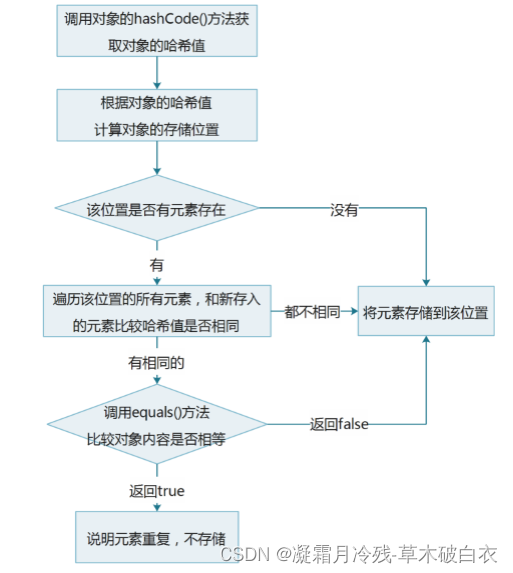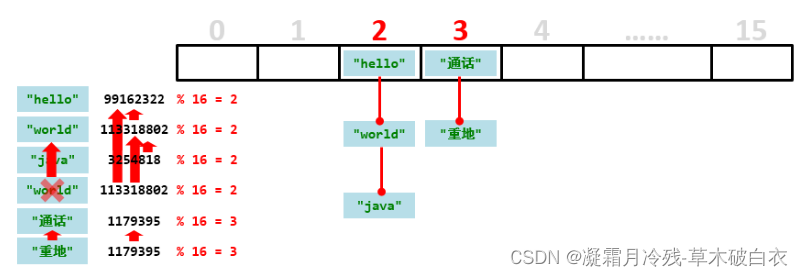1.Set集合
-
Set集合的特点
-
元素存取无序
-
没有索引、只能通过迭代器或增强for循环遍历
-
不能存储重复元素
-
-
Set集合的基本使用
public class SetDemo {
public static void main(String[] args) {
//创建集合对象
Set<String> set = new HashSet<String>();
//添加元素
set.add("hello");
set.add("world");
set.add("java");
//不包含重复元素的集合
set.add("world");
//遍历
for(String s : set) {
System.out.println(s);
}
}
}1.2哈希值
-
哈希值简介
是JDK根据对象的地址或者字符串或者数字算出来的int类型的数值
-
如何获取哈希值
Object类中的public int hashCode():返回对象的哈希码值
-
哈希值的特点
-
同一个对象多次调用hashCode()方法返回的哈希值是相同的
-
默认情况下,不同对象的哈希值是不同的。而重写hashCode()方法,可以实现让不同对象的哈希值相同
-
-
获取哈希值的代码
学生类
public class Student {
private String name;
private int age;
public Student() {
}
public Student(String name, int age) {
this.name = name;
this.age = age;
}
public String getName() {
return name;
}
public void setName(String name) {
this.name = name;
}
public int getAge() {
return age;
}
public void setAge(int age) {
this.age = age;
}
@Override
public int hashCode() {
return 0;
}
}测试类
public class HashDemo {
public static void main(String[] args) {
//创建学生对象
Student s1 = new Student("林青霞",30);
//同一个对象多次调用hashCode()方法返回的哈希值是相同的
System.out.println(s1.hashCode()); //1060830840
System.out.println(s1.hashCode()); //1060830840
System.out.println("--------");
Student s2 = new Student("林青霞",30);
//默认情况下,不同对象的哈希值是不相同的
//通过方法重写,可以实现不同对象的哈希值是相同的
System.out.println(s2.hashCode()); //2137211482
System.out.println("--------");
System.out.println("hello".hashCode()); //99162322
System.out.println("world".hashCode()); //113318802
System.out.println("java".hashCode()); //3254818
System.out.println("world".hashCode()); //113318802
System.out.println("--------");
System.out.println("重地".hashCode()); //1179395
System.out.println("通话".hashCode()); //1179395
}
}1.3HashSet集合概述和特点
-
HashSet集合的特点
-
底层数据结构是哈希表
-
对集合的迭代顺序不作任何保证,也就是说不保证存储和取出的元素顺序一致
-
没有带索引的方法,所以不能使用普通for循环遍历
-
由于是Set集合,所以是不包含重复元素的集合
-
-
HashSet集合的基本使用
public class HashSetDemo01 {
public static void main(String[] args) {
//创建集合对象
HashSet<String> hs = new HashSet<String>();
//添加元素
hs.add("hello");
hs.add("world");
hs.add("java");
hs.add("world");
//遍历
for(String s : hs) {
System.out.println(s);
}
}
}1.4HashSet集合保证元素唯一性源码分析
-
HashSet集合保证元素唯一性的原理
1.根据对象的哈希值计算存储位置
如果当前位置没有元素则直接存入
如果当前位置有元素存在,则进入第二步
2.当前元素的元素和已经存在的元素比较哈希值
如果哈希值不同,则将当前元素进行存储
如果哈希值相同,则进入第三步
3.通过equals()方法比较两个元素的内容
如果内容不相同,则将当前元素进行存储
如果内容相同,则不存储当前元素
-
HashSet集合保证元素唯一性的图解

1.5常见数据结构之哈希表

1.6HashSet集合存储学生对象并遍历
案例需求
-
创建一个存储学生对象的集合,存储多个学生对象,使用程序实现在控制台遍历该集合
-
要求:学生对象的成员变量值相同,我们就认为是同一个对象
学生类
public class Student {
private String name;
private int age;
public Student() {
}
public Student(String name, int age) {
this.name = name;
this.age = age;
}
public String getName() {
return name;
}
public void setName(String name) {
this.name = name;
}
public int getAge() {
return age;
}
public void setAge(int age) {
this.age = age;
}
@Override
public boolean equals(Object o) {
if (this == o) return true;
if (o == null || getClass() != o.getClass()) return false;
Student student = (Student) o;
if (age != student.age) return false;
return name != null ? name.equals(student.name) : student.name == null;
}
@Override
public int hashCode() {
int result = name != null ? name.hashCode() : 0;
result = 31 * result + age;
return result;
}
}测试类
public class HashSetDemo02 {
public static void main(String[] args) {
//创建HashSet集合对象
HashSet<Student> hs = new HashSet<Student>();
//创建学生对象
Student s1 = new Student("林青霞", 30);
Student s2 = new Student("张曼玉", 35);
Student s3 = new Student("王祖贤", 33);
Student s4 = new Student("王祖贤", 33);
//把学生添加到集合
hs.add(s1);
hs.add(s2);
hs.add(s3);
hs.add(s4);
//遍历集合(增强for)
for (Student s : hs) {
System.out.println(s.getName() + "," + s.getAge());
}
}
}1.7LinkedHashSet集合概述和特点
-
LinkedHashSet集合特点
-
哈希表和链表实现的Set接口,具有可预测的迭代次序
-
由链表保证元素有序,也就是说元素的存储和取出顺序是一致的
-
由哈希表保证元素唯一,也就是说没有重复的元素
-
-
LinkedHashSet集合基本使用
public class LinkedHashSetDemo {
public static void main(String[] args) {
//创建集合对象
LinkedHashSet<String> linkedHashSet = new LinkedHashSet<String>();
//添加元素
linkedHashSet.add("hello");
linkedHashSet.add("world");
linkedHashSet.add("java");
linkedHashSet.add("world");
//遍历集合
for(String s : linkedHashSet) {
System.out.println(s);
}
}
}2.Set集合排序
2.1TreeSet集合概述和特点
-
TreeSet集合概述
-
元素有序,可以按照一定的规则进行排序,具体排序方式取决于构造方法
-
TreeSet():根据其元素的自然排序进行排序
-
TreeSet(Comparator comparator) :根据指定的比较器进行排序
-
-
没有带索引的方法,所以不能使用普通for循环遍历
-
由于是Set集合,所以不包含重复元素的集合
-
-
TreeSet集合基本使用
public class TreeSetDemo01 {
public static void main(String[] args) {
//创建集合对象
TreeSet<Integer> ts = new TreeSet<Integer>();
//添加元素
ts.add(10);
ts.add(40);
ts.add(30);
ts.add(50);
ts.add(20);
ts.add(30);
//遍历集合
for(Integer i : ts) {
System.out.println(i);
}
}
}2.2自然排序Comparable的使用
-
案例需求
-
存储学生对象并遍历,创建TreeSet集合使用无参构造方法
-
要求:按照年龄从小到大排序,年龄相同时,按照姓名的字母顺序排序
-
-
实现步骤
-
用TreeSet集合存储自定义对象,无参构造方法使用的是自然排序对元素进行排序的
-
自然排序,就是让元素所属的类实现Comparable接口,重写compareTo(T o)方法
-
重写方法时,一定要注意排序规则必须按照要求的主要条件和次要条件来写
-
学生类
public class Student implements Comparable<Student> {
private String name;
private int age;
public Student() {
}
public Student(String name, int age) {
this.name = name;
this.age = age;
}
public String getName() {
return name;
}
public void setName(String name) {
this.name = name;
}
public int getAge() {
return age;
}
public void setAge(int age) {
this.age = age;
}
@Override
public int compareTo(Student s) {
// return 0;
// return 1;
// return -1;
//按照年龄从小到大排序
int num = this.age - s.age;
// int num = s.age - this.age;
//年龄相同时,按照姓名的字母顺序排序
int num2 = num==0?this.name.compareTo(s.name):num;
return num2;
}
}测试类
public class TreeSetDemo02 {
public static void main(String[] args) {
//创建集合对象
TreeSet<Student> ts = new TreeSet<Student>();
//创建学生对象
Student s1 = new Student("xishi", 29);
Student s2 = new Student("wangzhaojun", 28);
Student s3 = new Student("diaochan", 30);
Student s4 = new Student("yangyuhuan", 33);
Student s5 = new Student("linqingxia",33);
Student s6 = new Student("linqingxia",33);
//把学生添加到集合
ts.add(s1);
ts.add(s2);
ts.add(s3);
ts.add(s4);
ts.add(s5);
ts.add(s6);
//遍历集合
for (Student s : ts) {
System.out.println(s.getName() + "," + s.getAge());
}
}
}2.3比较器排序Comparator的使用
-
案例需求
-
存储学生对象并遍历,创建TreeSet集合使用带参构造方法
-
要求:按照年龄从小到大排序,年龄相同时,按照姓名的字母顺序排序
-
-
实现步骤
-
用TreeSet集合存储自定义对象,带参构造方法使用的是比较器排序对元素进行排序的
-
比较器排序,就是让集合构造方法接收Comparator的实现类对象,重写compare(T o1,T o2)方法
-
重写方法时,一定要注意排序规则必须按照要求的主要条件和次要条件来写
-
学生类
public class Student {
private String name;
private int age;
public Student() {
}
public Student(String name, int age) {
this.name = name;
this.age = age;
}
public String getName() {
return name;
}
public void setName(String name) {
this.name = name;
}
public int getAge() {
return age;
}
public void setAge(int age) {
this.age = age;
}
}测试类
public class TreeSetDemo {
public static void main(String[] args) {
//创建集合对象
TreeSet<Student> ts = new TreeSet<Student>(new Comparator<Student>() {
@Override
public int compare(Student s1, Student s2) {
//this.age - s.age
//s1,s2
int num = s1.getAge() - s2.getAge();
int num2 = num == 0 ? s1.getName().compareTo(s2.getName()) : num;
return num2;
}
});
//创建学生对象
Student s1 = new Student("xishi", 29);
Student s2 = new Student("wangzhaojun", 28);
Student s3 = new Student("diaochan", 30);
Student s4 = new Student("yangyuhuan", 33);
Student s5 = new Student("linqingxia",33);
Student s6 = new Student("linqingxia",33);
//把学生添加到集合
ts.add(s1);
ts.add(s2);
ts.add(s3);
ts.add(s4);
ts.add(s5);
ts.add(s6);
//遍历集合
for (Student s : ts) {
System.out.println(s.getName() + "," + s.getAge());
}
}
}2.4成绩排序案例
-
案例需求
-
用TreeSet集合存储多个学生信息(姓名,语文成绩,数学成绩),并遍历该集合
-
要求:按照总分从高到低出现
-
学生类
public class Student {
private String name;
private int chinese;
private int math;
public Student() {
}
public Student(String name, int chinese, int math) {
this.name = name;
this.chinese = chinese;
this.math = math;
}
public String getName() {
return name;
}
public void setName(String name) {
this.name = name;
}
public int getChinese() {
return chinese;
}
public void setChinese(int chinese) {
this.chinese = chinese;
}
public int getMath() {
return math;
}
public void setMath(int math) {
this.math = math;
}
public int getSum() {
return this.chinese + this.math;
}
}测试类
public class TreeSetDemo {
public static void main(String[] args) {
//创建TreeSet集合对象,通过比较器排序进行排序
TreeSet<Student> ts = new TreeSet<Student>(new Comparator<Student>() {
@Override
public int compare(Student s1, Student s2) {
// int num = (s2.getChinese()+s2.getMath())-(s1.getChinese()+s1.getMath());
//主要条件
int num = s2.getSum() - s1.getSum();
//次要条件
int num2 = num == 0 ? s1.getChinese() - s2.getChinese() : num;
int num3 = num2 == 0 ? s1.getName().compareTo(s2.getName()) : num2;
return num3;
}
});
//创建学生对象
Student s1 = new Student("林青霞", 98, 100);
Student s2 = new Student("张曼玉", 95, 95);
Student s3 = new Student("王祖贤", 100, 93);
Student s4 = new Student("柳岩", 100, 97);
Student s5 = new Student("风清扬", 98, 98);
Student s6 = new Student("左冷禅", 97, 99);
// Student s7 = new Student("左冷禅", 97, 99);
Student s7 = new Student("赵云", 97, 99);
//把学生对象添加到集合
ts.add(s1);
ts.add(s2);
ts.add(s3);
ts.add(s4);
ts.add(s5);
ts.add(s6);
ts.add(s7);
//遍历集合
for (Student s : ts) {
System.out.println(s.getName() + "," + s.getChinese() + "," + s.getMath() + "," + s.getSum());
}
}
}2.5不重复的随机数案例
-
案例需求
-
编写一个程序,获取10个1-20之间的随机数,要求随机数不能重复,并在控制台输出
-
public class SetDemo {
public static void main(String[] args) {
//创建Set集合对象
// Set<Integer> set = new HashSet<Integer>();
Set<Integer> set = new TreeSet<Integer>();
//创建随机数对象
Random r = new Random();
//判断集合的长度是不是小于10
while (set.size()<10) {
//产生一个随机数,添加到集合
int number = r.nextInt(20) + 1;
set.add(number);
}
//遍历集合
for(Integer i : set) {
System.out.println(i);
}
}
}





















 921
921











 被折叠的 条评论
为什么被折叠?
被折叠的 条评论
为什么被折叠?








